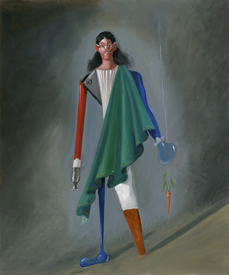
May 26 - July 10, 2004 |
GEORGE CONDO
|
MEMORIES OF MANET AND VELAZQUEZ
|
galerie jerome de noirmont
|

exhibition release
Memories of Manet and Velázquez, the exhibition shown at the gallery from May 26 to July 10, is a new and basic stage in Condo’s boundless trip through history of art. 26 oils on canvas, created in 2003, of different sizes, compose this emotive tribute…
American painter marked with European culture, great admirer of Old Masters’ paintings, mostly French and Spanish, George Condo fits here more than ever in a very classical, indeed even academic, reinterpretation process of his illustrious predecessors’ works.
As art historians contemplating historical portraits and frescoes focus on what was actual fact and what was the painter’s imagination, Condo decodes Manet’s and Velazquez’ works by focusing on the essence and the symbolism of their compositions. If the figure refers to a real character, the way this character is depicted is fictive, as resulting from the artist’s vision. George Condo’s main interest in Old Masters’ reinterpretation is precisely the “way it was painted”, the way the figure has been characterized.
Thus, the work called Yankee Doodle is Condo’s response to The Fifer by Manet . As in the famous painting of 1866, a figure stands in an undetermined grey space. The fragmented composite in essentially red, white and blue symbolizes a man whom has been sold a dream that could never be. Condo endows him with a blown glass golf club (the golf club suggesting the Promised Land), with laboratory bottles (which embody the innovative spirit of the first American scientists such as Edison or Franklin), and his main attribute is a carrot (symbol of false hopes). Standing before the viewer, seeking neither praise nor criticism, he simply is what he is, that which he becomes: the Yankee Doodle , is like the American trapped by “the American dream”.
The use of diagonals in several works of this series is another excellent example of the way George Condo transcribes the Old Master’s composition techniques in his own paintings.
George Condo uses of an expressive disposition of lines and of a composition similar to the Masters’ one, to give depth and perspective to his works and to “characterize” his figures.
The figure is only a way to describe an already abstract image, to reconstruct it or to deconstruct it, are basically the same - the way it is painted is what makes it interesting.
Condo’s fanciful spirit, his fascination for popular imagery and contemporary illustration melt to his rich knowledge in history of art bring us beyond this quest of composition, to the boundaries between figuration and abstraction, between reality and fiction.
In several exhibited works, George Condo deals with his particular iconography, which combines past and present, cartoons and classical painting, rational and irrational to give birth to amazing portraits that become timeless for the contemplative viewer.
This mixture of times and styles are actually for Condo a “reverse configuration”: a scientist reworking historical master paintings and reconfiguring an intense engagement with historical work in completely fresh imaginative, utterly contemporary way. Like Kubrick looking back at Spartacus, or Manet looking at Velazquez, George Condo is going back in time to go forward.









